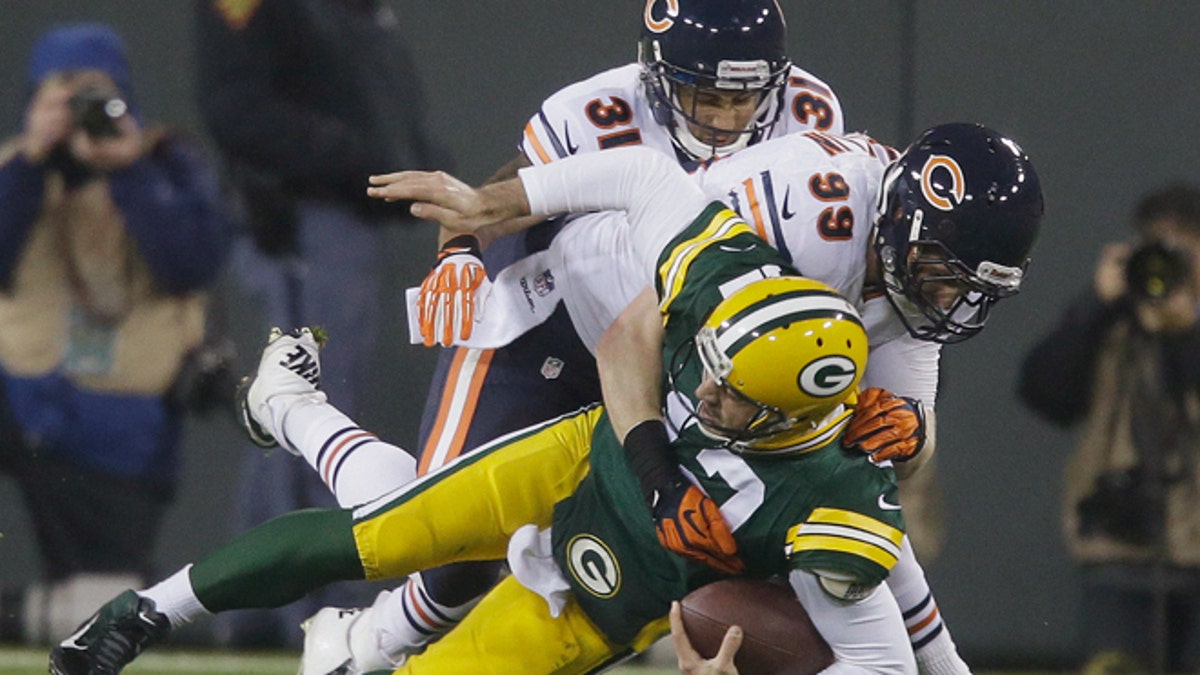
FILE -- Nov. 4, 2013: Green Bay Packers quarterback Aaron Rodgers is sacked by Chicago Bears' Shea McClellin (99) and Isaiah Frey (31) during the first half of an NFL football game in Green Bay, Wis. Rodgers left the game after the play. (AP Photo/Jeffrey Phelps)
A new HBO Real Sports/Marist poll reports that a third of Americans say that concern over long-term brain issues would make them less likely to allow a son to play football.
“I advise [kids] and their parents to avoid the game at all costs,” Roxanne Jones, a founding editor of ESPN the Magazine, writes at CNN.com. “It’s not safe at any level.”
But last year when the Mayo Clinic compared neurodegenerative disease rates from mid-century high school football players with their counterparts in band, choir, and glee club they discovered no real difference.
The five doctors admit that their findings rebutted their incoming hypothesis: “Indeed, the frequency of [Parkinson’s] and [Lou Gehrig’s Disease] was lower in the football group than in the band, glee club, and choir group.”
Growing numbers of parents steering kids away from the gridiron doesn’t reflect growing dangers. It represents growing hysteria.
- Broncos’ John Moffitt walks away from NFL, $1 million over ‘madness’ of risking health
- Dolphins tackle in bullying case ‘doing well,’ father says
- A Rosa Parks moment for the NFL?
- Packers’ Jones active for Monday Night Football
- Kris Kristofferson opens up about memory loss and his ‘blessed’ life as a cowboy in Hollywood
[pullquote]
“For all [NFL] players who play five or more years,” George Will explained in a column last year, “life expectancy is less than 60; for linemen it is much less.” The urban myth that football truncates lifespan appeared in an ABC News report, on the front page of the Boston Globe, and at ESPN.com, among scores of other news outlets.
The truth is that playing football for a long time coincides with living for a long time. That’s what the National Institute for Occupational Safety and Health (NIOSH) discovered after looking at every pension-vested player who competed in the NFL between 1959 and 1988.
Federal researchers expected an 18 percent mortality rate among the players based upon comparable societal rates. They discovered a 10 percent mortality rate.
The NIOSH study showed NFL retirees benefitting from 62 fewer deaths from cancer than prevailing peer rates would indicate, 60 fewer from cardiovascular disease, 13 fewer from suicides, and 9 fewer from diabetes. A prolonged football career—running and jumping, diet and training, medical attention and vice restraint—saves lives.
In seventeen categories of killers, players experienced decreased mortality in all but three. “Diseases of nervous system and sense organs,” the maladies one would expect to skyrocket if football hits caused widespread brain damage, killed 2.3 more NFL retirees than expected.
These 12 players dying from neurodegenerative causes represent about one-third of one percent of the 3,439 players studied and less than four percent of the 334 total deaths within that cohort.
And given that older populations are at greater risk for neurodegenerative diseases, the overall longevity may ironically help to explain the subpar statistics on ALS, Alzheimer’s, and other similar maladies.
As Loyola Medical Center’s Christopher Randolph, NYU Medical Center’s Stella Karantzoulis, and the University of North Carolina’s Kevin Guskiewicz recently pointed out, “The much lower overall mortality rate for retirees (~ 50% of expected all-cause mortality) could also have resulted in disproportionate rates of deaths due to neurodegenerative causes in that population relative to the general population.”
Still, higher rates, particularly given NIOSH’s follow-up study showing elevated rates of Alzheimer’s and ALS for NFL skill players, suggest that certain positions played for a long time at an elite level does the brain few favors.
But to fixate on 2 additional lives lost through diseases of the nervous system and sensory organs while ignoring the 291 lives saved in all mortality categories illustrates the problem football faces: even good news becomes bad news in the media feeding frenzy.
Accustomed to baseless claims becoming conventional wisdom, football’s complainer-chorus has begun condemning all of its players to a scrambled-brain existence.
The recent PBS documentary "League of Denial" advanced a claim that the tens of millions of American men who once played football may all come down with CTE. Researcher Ann McKee maintained, “I’m really wondering on some level if every football player doesn’t have this.”
But McKee’s peers have looked at CTE-free brains from players, and given that none of them have been able to replicate McKee’s near-perfect success rate of finding CTE in former players, inherently curious scientists have begun to ask questions.
Why does McKee’s definition of CTE differ from the one used by other scientists?
What’s the value of autopsies done with an admitted “selection bias” on brains suspected to have been damaged?
Why does McKee make sweeping assertions based on anecdotes and not a randomized study, which has yet to be conducted?
When McKee’s peers gathered at the 4th International Conference on Concussion in Sport last year, they announced in a consensus statement that “a cause and effect relationship has not as yet been demonstrated between CTE and concussions or exposure to contact sports.” But the public, which gets its science from PBS documentaries rather academic conferences, gleans the opposite impression.
Cherry-picking data, mistaking speculation for science, and inventing studies out of thin air make us ignorant rather than enlightened.
Science doesn’t always confirm our suspicions, which is good reason to stop calling our suspicions “science” on football.
Football is good for us. Deception surely isn’t.
